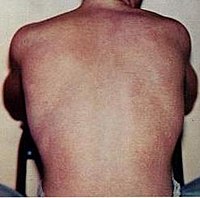
Photo from wikipedia
Background At least a third of dengue patients develop plasma leakage with increased risk of life-threatening complications. Predicting plasma leakage using laboratory parameters obtained in early infection as means of… Click to show full abstract
Background At least a third of dengue patients develop plasma leakage with increased risk of life-threatening complications. Predicting plasma leakage using laboratory parameters obtained in early infection as means of triaging patients for hospital admission is important for resource-limited settings. Methods A Sri Lankan cohort including 4,768 instances of clinical data from N = 877 patients (60.3% patients with confirmed dengue infection) recorded in the first 96 hours of fever was considered. After excluding incomplete instances, the dataset was randomly split into a development and a test set with 374 (70%) and 172 (30%) patients, respectively. From the development set, five most informative features were selected using the minimum description length (MDL) algorithm. Random forest and light gradient boosting machine (LightGBM) were used to develop a classification model using the development set based on nested cross validation. An ensemble of the learners via average stacking was used as the final model to predict plasma leakage. Results Lymphocyte count, haemoglobin, haematocrit, age, and aspartate aminotransferase were the most informative features to predict plasma leakage. The final model achieved the area under the receiver operating characteristics curve, AUC = 0.80 with positive predictive value, PPV = 76.9%, negative predictive value, NPV = 72.5%, specificity = 87.9%, and sensitivity = 54.8% on the test set. Conclusion The early predictors of plasma leakage identified in this study are similar to those identified in several prior studies that used non-machine learning based methods. However, our observations strengthen the evidence base for these predictors by showing their relevance even when individual data points, missing data and non-linear associations were considered. Testing the model on different populations using these low-cost observations would identify further strengths and limitations of the presented model.
Journal Title: PLOS Neglected Tropical Diseases
Year Published: 2023
Link to full text (if available)
Share on Social Media: Sign Up to like & get
recommendations!